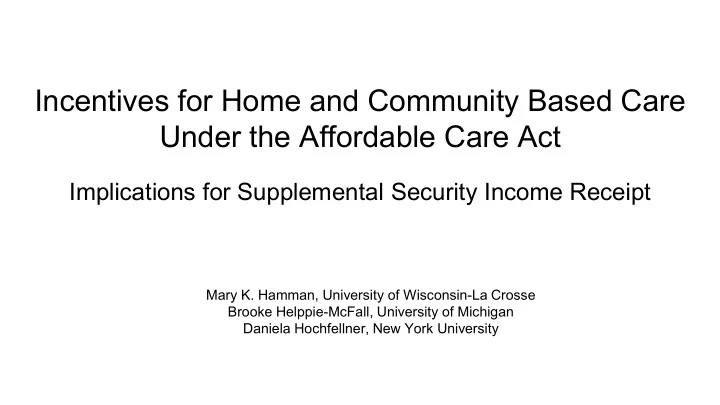

Incentives for Home and Community Based Care Under the Affordable Care Act Implications for Supplemental Security Income Receipt Mary K. Hamman, University of Wisconsin-La Crosse Brooke Helppie-McFall, University of Michigan Daniela Hochfellner, New York University
The authors gratefully acknowledge support from the Social Security Administration The research reported herein was performed pursuant to a grant from the U.S. Social Security Administration (SSA) funded as part of the Retirement and Disability Consortium. The opinions and conclusions expressed are solely those of the author(s) and do not represent the opinions or policy of SSA or any agency of the Federal Government. Neither the United States Government nor any agency thereof, nor any of their employees, makes any warranty, express or implied, or assumes any legal liability or responsibility for the accuracy, completeness, or usefulness of the contents of this report. Reference herein to any specific commercial product, process or service by trade name, trademark, manufacturer, or otherwise does not necessarily constitute or imply endorsement, recommendation or favoring by the United States Government or any agency thereof.
Outline of the presentation 1. The Balancing Incentive Program 2. Contribution 3. Empirical Strategy 4. Results 5. Conclusion 6. Supplemental Material
The Balancing Incentives Program sought to "catch- up" states with low HCBS spending ● $3 billion authorized from 2011 through 2015 to support enhanced FMAP for: ○ States spending less than 50\% of total Medicaid LTSS budget on HCBS in FY2009 ○ One state eligible for 5 point increase ○ The rest for 2 point increase ○ 38 states were eligible ● 21 were approved ● 18 participated through May of 2015 ● 15 of these focused on older adults
The 15 states focusing on older adults are distributed across regions
They receive different amounts of funds without the BIP
Additional BIP funds are proportionate to FMAP
We know that BIP increased spending
What we don't know yet is ● Whether the BIP moved people from institutionalized care into home care, or prevented moves into institutionalized care. ● What this means for SSI.
Hypotheses The BIP will: ● Reduce the share of older adults living in institutional settings. ● Increase the share receiving SSI.
Data ● American Community Survey (ACS): N ~ 4 Million ○ Years: 2006 – 2017 ○ Sample: Adults 65+ \& control and treatment group states. ○ Pros: Very large annual survey, including institutionalized population since 2006. ○ Cons: Pooled cross-section, with blunt measures of disability and SSI receipt (relative to HRS or SIPP). ● Health and Retirement Study (HRS): N = 36,672 ○ Years: 2006 -- 2016 ○ Sample: Adults 65+ \& control and treatment group states. ○ Pros: Longitudinal, cohort-based study with expansive measures. ○ Cons: Sample size, and only conducted biennially.
Timing of the BIP was staggered
Treatment and control group
Staggered treatment "difference-in-differences" Estimates are weighted using survey weights, and heteroskedasticity robust standard errors are clustered at the state level.
Outcomes and controls Outcomes: Institutional Residence, Receive any SSI , Cohabitating with Family, Moved in Past Year, Amount SSI given Any. Controls: Sex, Age, Marital Status, Race and Ethnicity, Educational Attainment, Total Income, Widowed in last 12 months, Not US born.
Difference-in-differences results
Our estimates vs. expected effect sizes* *Expected effects computed from estimates in Mor et al (2007)
Why did SSI receipt increase?
Key take home points ● BIP was not associated with reductions in institutionalization. ● But the share of persons receiving SSI did increase. ● Perhaps due to reductions in cohabitation.
BIP aside, there are important changes in residency and SSI
Especially cohabitation with adult children
New questions to be answered ● Are cohabiting older adults caring for grandchildren? Are they receiving informal care? ● What are the labor supply effects of these changes in residency for adult children?
Appendix ● Complete Difference-in-Difference Estimates for HRS ● Complete Difference-in-Difference Estimates for ACS ● Triple Difference-in-Difference Estimates for ACS
DD estimates for all HRS outcomes
DD estimates for all ACS outcomes
DDD estimates for all ACS outcomes: age 80+
DDD estimates for all ACS outcomes: income <=$15,000
Recommend
More recommend